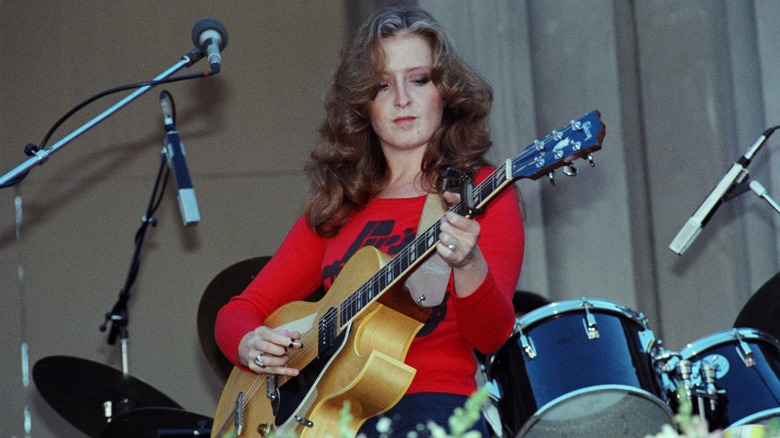Bonnie Raitt stands as one of the most respected musicians in the world, known for her powerful blues-rock vocals, masterful slide guitar skills, and a career that spans over five decades. Her music seamlessly blends blues, rock, folk, and country, creating a distinctive sound that has captivated audiences worldwide. From her early beginnings to her current endeavors, Raitt’s journey is marked by passion, activism, and a relentless dedication to her craft.
Early Life: Growing Up in a Musical Household

Born Bonnie Lynn Raitt on November 8, 1949, in Burbank, California, music was an intrinsic part of her upbringing. Her father, John Raitt, was a renowned Broadway star, famous for his roles in Carousel and The Pajama Game, while her mother, Marjorie Haydock, was a skilled pianist. Surrounded by music at home, young Bonnie was naturally drawn to it, developing an early love for the blues.
By her teenage years, she was inspired by legendary blues artists like Muddy Waters and Mississippi Fred McDowell. Fueled by this passion, she picked up the guitar, eventually mastering the slide guitar—a skill that would later define her distinctive musical style.
College Years and the Road to Blues

Raitt attended Radcliffe College in Massachusetts, where she studied social relations and African studies. However, her college years were as much about music as academics. Immersed in the local folk and blues scene, she began performing at clubs, refining her guitar skills, and developing her soulful voice. It was during this time that Raitt started to experiment with the slide guitar, which soon became her signature sound.
In the early 1970s, she made a bold decision to pursue music full-time, stepping onto a path that would shape her legacy. Her unique sound quickly attracted attention from record producers, leading to her self-titled debut album, Bonnie Raitt (1971). While it didn’t achieve immediate commercial success, it marked her as a rising star in the blues scene, characterized by a blend of blues, folk, and country influences.
Rising Fame in the 1970s: A Blend of Genres
Throughout the 1970s, Bonnie Raitt continued to release albums that showcased her talent and versatility. Albums like Give It Up (1972), Takin’ My Time (1973), and Sweet Forgiveness (1977) solidified her position as a skilled artist. Her cover of Del Shannon’s “Runaway” from Sweet Forgiveness became her first hit single, earning her more recognition.
However, mainstream success was elusive due to the changing musical landscape, which was dominated by pop and disco. Still, Raitt’s passionate performances and slide guitar prowess kept her relevant, with a loyal fan base that appreciated her authentic sound.
The 1980s: Struggles and a Major Comeback

The 1980s were a challenging period for Raitt, both personally and professionally. Albums like The Glow (1979) and Green Light (1982) didn’t achieve significant commercial success. Simultaneously, Raitt faced personal struggles, battling substance abuse. Despite these hardships, she remained a resilient artist, staying active in the music scene.
A turning point came in 1989 with the release of Nick of Time. This album marked a triumphant comeback, earning critical acclaim and massive commercial success. It topped the Billboard 200 chart and won three Grammy Awards, including Album of the Year. This success not only revived her career but also cemented her status as one of the most respected musicians of her generation.
1990s Success: ‘Luck of the Draw’ and Beyond

The 1990s were marked by a series of successful albums, starting with Luck of the Draw (1991), which featured hits like:
- “Something to Talk About” – A catchy, bluesy track that became a signature song for Raitt.
- “I Can’t Make You Love Me” – A heart-wrenching ballad that showcased Raitt’s emotional depth and vocal prowess.
Both songs helped her reach a wider audience, earning her more Grammy Awards and solidifying her crossover appeal. Throughout the decade, Raitt remained true to her blues roots while exploring new sounds in albums like Longing in Their Hearts (1994) and Fundamental (1998). Her music continued to blend blues, rock, and folk, demonstrating her adaptability as an artist.
During this time, Raitt also became an active advocate for social and environmental causes, supporting human rights, music education, and environmental conservation. Her music and activism worked hand-in-hand, making her an inspiring figure for fans and fellow musicians alike.
2000s and 2010s: Reinvention and Recognition

In the 2000s, Raitt’s music continued to evolve. Albums like Silver Lining (2002) and Souls Alike (2005) kept her at the forefront of the music scene, with hits like “I Can’t Help You Now” showcasing her enduring relevance. Her efforts culminated in her induction into the Rock and Roll Hall of Fame in 2000, a testament to her lasting influence.
In 2012, she released Slipstream, an album that earned her another Grammy Award for Best Americana Album. It featured a blend of classic blues and contemporary sounds, underscoring her enduring appeal. Her 2016 release, Dig in Deep, further demonstrated her commitment to raw, soulful music.
Recent Work: ‘Just Like That…’ and Beyond

Today, Bonnie Raitt continues to create music and inspire audiences worldwide. In 2022, she released Just Like That…, an album that explores themes of love, loss, and redemption with her signature blend of blues, rock, and Americana influences. The album received critical acclaim, with tracks like “Made Up Mind” and “Waitin’ For You to Blow” highlighting her continued musical prowess.
Raitt also remains an active advocate for climate change awareness, music education, and social justice, frequently participating in benefit concerts and collaborating with organizations to promote positive change.
Conclusion
Bonnie Raitt’s journey is one of passion, authenticity, and resilience. From her early days as a young blues enthusiast to becoming a music icon, Raitt has consistently stayed true to her roots while evolving as an artist. Her distinctive blend of blues, rock, and folk, coupled with her advocacy for social causes, sets her apart as not only a legendary musician but also a role model.
With over 10 Grammy Awards, a place in the Rock and Roll Hall of Fame, and a lasting impact on music and activism, Bonnie Raitt has secured her legacy as one of the most influential musicians of all time. As she continues to create and perform, her music and message prove that Bonnie Raitt’s flame will burn bright for years to come.


